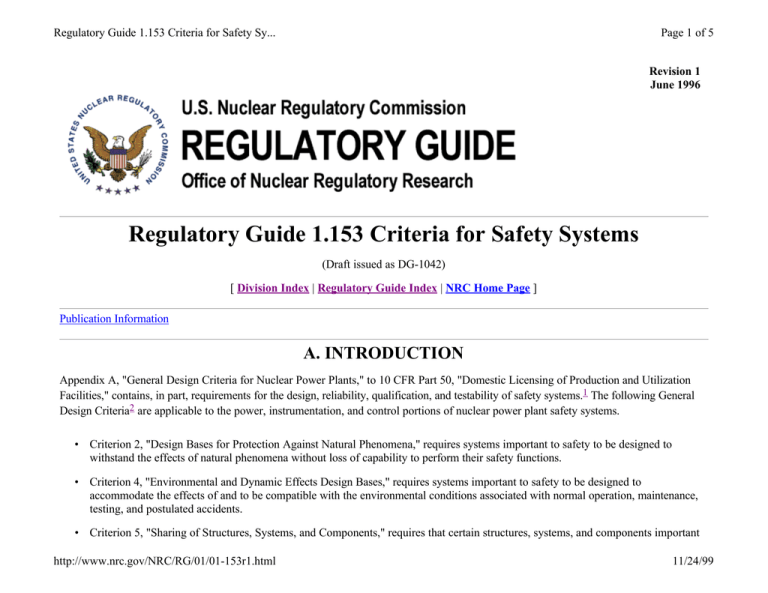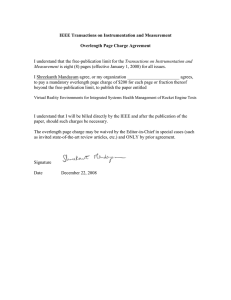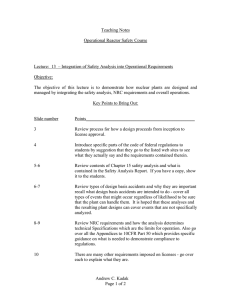Regulatory Guide 1.153 Criteria for Safety Systems
advertisement

Regulatory Guide 1.153 Criteria for Safety Sy... Page 1 of 5 Revision 1 June 1996 Regulatory Guide 1.153 Criteria for Safety Systems (Draft issued as DG-1042) [ Division Index | Regulatory Guide Index | NRC Home Page ] Publication Information A. INTRODUCTION Appendix A, "General Design Criteria for Nuclear Power Plants," to 10 CFR Part 50, "Domestic Licensing of Production and Utilization Facilities," contains, in part, requirements for the design, reliability, qualification, and testability of safety systems.1 The following General Design Criteria2 are applicable to the power, instrumentation, and control portions of nuclear power plant safety systems. • Criterion 2, "Design Bases for Protection Against Natural Phenomena," requires systems important to safety to be designed to withstand the effects of natural phenomena without loss of capability to perform their safety functions. • Criterion 4, "Environmental and Dynamic Effects Design Bases," requires systems important to safety to be designed to accommodate the effects of and to be compatible with the environmental conditions associated with normal operation, maintenance, testing, and postulated accidents. • Criterion 5, "Sharing of Structures, Systems, and Components," requires that certain structures, systems, and components important http://www.nrc.gov/NRC/RG/01/01-153r1.html 11/24/99 Regulatory Guide 1.153 Criteria for Safety Sy... Page 2 of 5 to safety not be shared among nuclear power units unless it can be shown that such sharing will not significantly impair their ability to perform their safety functions. • Criterion 10, "Reactor Design," requires protection systems to be designed with margins to ensure that fuel design limits are not exceeded. • Criterion 12, "Suppression of Reactor Power Oscillations," requires protection systems to be designed to prevent or detect and suppress power oscillations that can result in conditions exceeding fuel design limits. • Criterion 13, "Instrumentation and Control," requires that instrumentation be provided to monitor variables and systems over their anticipated ranges for normal operation, anticipated operational occurrences, and accident conditions to assure adequate safety. Appropriate controls must be provided to maintain variables and systems within prescribed operating ranges. • Criterion 15, "Reactor Coolant System Design," requires that the reactor coolant system and associated auxiliary, control, and protection systems be designed with sufficient margin to ensure that the design conditions of the reactor coolant pressure boundary are not exceeded during any condition of normal operation, including anticipated operational occurrences. • Criterion 17, "Electric Power Systems," requires electric power systems to be provided to permit functioning of structures, systems, and components important to safety. • Criterion 18, "Inspection and Testing of Electric Power Systems," requires that electric power systems important to safety be designed to permit periodic inspection and testing of such systems for operability and functional performance. • Criterion 20, "Protection System Functions," requires a protection system to sense accident conditions and initiate operation of systems important to safety to ensure that acceptable fuel design limits are not exceeded. • Criterion 21, "Protection System Reliability and Testability," requires the protection system to be designed with high functional reliability and in-service testability. This criterion also requires redundancy and independence sufficient to provide protection against single failures and loss of redundancy, except where justified, in the event equipment is removed for service. On-line testing is required. • Criterion 22, "Protection System Independence," requires that the effects of natural phenomena, normal operation, maintenance, testing, and postulated accident conditions on redundant channels not result in loss of the protection function. Functional diversity or diversity in component design and principles of operation must be used to the extent practical to prevent loss of the protection function. • Criterion 23, "Protection System Failure Modes," requires that the protection system be designed to fail into a safe state or into a state demonstrated to be acceptable on some other defined basis if conditions such as disconnection of the system, loss of energy, or http://www.nrc.gov/NRC/RG/01/01-153r1.html 11/24/99 Regulatory Guide 1.153 Criteria for Safety Sy... Page 3 of 5 postulated adverse environments are experienced. • Criterion 24, "Separation of Protection and Control Systems," requires separation of protection and control systems to the extent that failure of any single control system component or channel, or failure or removal from service of any single protection system component or channel that is common to the control and protection systems, leaves intact a system satisfying all reliability, redundancy, and independence requirements of the protection system. Interconnection of the protection and control systems is to be limited to ensure that safety is not significantly impaired. • Criterion 25, "Protection System Requirements for Reactivity Control Malfunctions," requires that the protection system be designed to ensure that specified acceptable fuel design limits will not be exceeded for any single malfunction of the reactivity control systems. • Criterion 29, "Protection Against Anticipated Operational Occurrences," requires that protection and reactivity control systems be designed to be highly reliable in accomplishing their safety functions in the event of anticipated operational occurrences. • Criteria 34, "Residual Heat Removal"; 35, "Emergency Core Cooling"; 38, "Containment Heat Removal"; 41, "Containment Atmosphere Cleanup"; and 44, "Cooling Water," require suitable redundancy, interconnections, and isolation capabilities to ensure that, for onsite and for offsite electric power system operation, the safety function can be accomplished. • Criteria 37, "Testing of Emergency Core Cooling System"; 40, "Testing of Containment Heat Removal System"; 43, "Testing of Containment Atmosphere Cleanup Systems"; and 46, "Testing of Cooling Water System," require designs to permit periodic functional testing of these systems, the operability and performance of the active components of the system, and the operability of each of these systems as a whole, including the full operational sequence that brings each system into operation. • Criterion 54, "Piping Systems Penetrating Containment," requires redundancy, reliability, and performance capabilities that reflect the importance to safety of isolating these systems. Capability for periodic testing is also required. In addition, 10 CFR 50.55a, "Codes and Standards," requires in paragraph (h) that protection systems meet the requirements set forth in IEEE Std 279-1971 (ANSI N42.7-1972), "Criteria for Protection Systems for Nuclear Power Generating Stations."3 Further, 10 CFR 50.49, "Environmental Qualification of Electric Equipment Important to Safety for Nuclear Power Plants," requires that a program be established for qualifying safety-related electric equipment, nonsafety-related electric equipment whose failure under postulated environmental conditions could prevent satisfactory accomplishment of its safety functions, and certain post-accident monitoring equipment. This guide describes a method acceptable to the NRC staff for complying with the Commission's regulations with respect to the design, reliability, qualification, and testability of the power, instrumentation, and control portions of safety systems of nuclear plants. The Advisory Committee on Reactor Safeguards has been consulted concerning this guide and has concurred in the regulatory position. http://www.nrc.gov/NRC/RG/01/01-153r1.html 11/24/99 Regulatory Guide 1.153 Criteria for Safety Sy... Page 4 of 5 The information collections mentioned in this regulatory guide are covered by the requirements of 10 CFR Part 50, which were approved by the Office of Management and Budget, approval number 3150-0011. The NRC may not conduct or sponsor, and a person is not required to respond to, a collection of information unless it displays a currently valid OMB control number. B. DISCUSSION IEEE Std. 603-1991, "Criteria for Safety Systems for Nuclear Power Generating Stations,"3 was prepared by the Safety Systems Working Group SC 6.3 of the IEEE Nuclear Power Engineering Committee, and it was approved by the IEEE Standards Board on June 27, 1991. A correction sheet was issued on January 30, 1995. IEEE Std. 603-1991 establishes minimum functional and design requirements for the power, instrumentation, and control portions of safety systems for nuclear power plants. Section 1.2 of IEEE Std. 603-1991 references IEEE/ANS 7.4.3.2-1982. Revision 1 to Regulatory Guide 1.152, "Criteria for Digital Computers in Safety Systems of Nuclear Power Plants," endorses the 1993 version, IEEE Std. 7-4.3.2-1993, "Standard Criteria for Digital Computers in Safety Systems of Nuclear Power Generating Stations." Thus, Revision 1 to Regulatory Guide 1.152 constitutes an acceptable method of meeting the regulatory requirements for digital computers. It should be noted that Section 5.8.1 of IEEE Std. 603-1991 references IEEE Std. 497-1981, "IEEE Standard Criteria for Accident Monitoring Instrumentation for Nuclear Power Generating Stations." In this area, Revision 3 of Regulatory Guide 1.97, "Instrumentation for Light-Water-Cooled Nuclear Power Plants To Assess Plant and Environs Conditions During and Following an Accident," provides an acceptable method to meet the regulations for accident monitoring instrumentation. C. REGULATORY POSITION Conformance with the requirements of IEEE Std. 603-1991, "Criteria for Safety Systems for Nuclear Power Generating Stations" (including the correction sheet dated January 30, 1995), provides a method acceptable to the NRC staff for satisfying the Commission's regulations with respect to the design, reliability, qualification, and testability of the power, instrumentation, and control portions of the safety systems of nuclear power plants. Section 3 of IEEE Std. 603-1991 references several industry codes and standards. If a referenced standard has been incorporated separately into the Commission's regulations, licensees and applicants must comply with that standard as set forth in the regulation. If the referenced standard has been endorsed in a regulatory guide, the standard constitutes a method acceptable to the NRC staff of meeting a regulatory requirement as described in the regulatory guide. If a referenced standard has been neither incorporated into the Commission's regulations nor endorsed in a regulatory guide, licensees and applicants may consider and use the information in the referenced standard if appropriately justified, consistent with current regulatory practice. http://www.nrc.gov/NRC/RG/01/01-153r1.html 11/24/99 Regulatory Guide 1.153 Criteria for Safety Sy... Page 5 of 5 D. IMPLEMENTATION The purpose of this section is to provide information to applicants and licensees regarding the NRC staff's plans for using this guide. Except in those cases in which an applicant or licensee proposes an acceptable alternative method for complying with specified portions of the Commission's regulations, the methods described in this guide will be used in the evaluation of submittals in connection with applications for construction permits and operating licenses. It will also be used to evaluate submittals from operating reactor licensees who voluntarily propose to initiate system modifications if there is a clear nexus between the proposed modifications and this guidance. VALUE/IMPACT STATEMENT A draft Value/Impact Statement was published with the draft of this guide, Task DG-1042, when it was published for public comment in November 1995. No changes were necessary, so a separate value/impact statement for this final guide has not been prepared. A copy of the draft Value/Impact Statement is available for inspection or copying for a fee in the Commission's Public Document Room at 2120 L Street NW., Washington, DC, under Task DG-1042. [ Division Index | Regulatory Guide Index | NRC Home Page ] Footnotes 1 The term "safety systems" is synonymous with "safety-related" systems. The general design criteria cover structures, systems, and components "important to safety." The scope of this guide is, however, limited to "safety systems," which are a subset of "systems important to safety." 2 For 3 the full text of the applicable General Design Criteria, see Appendix A to 10 CFR Part 50. Copies may be obtained from the Institute of Electrical and Electronics Engineers Service Center, 445 Hoes Lane, Piscataway, NJ 08855. http://www.nrc.gov/NRC/RG/01/01-153r1.html 11/24/99



